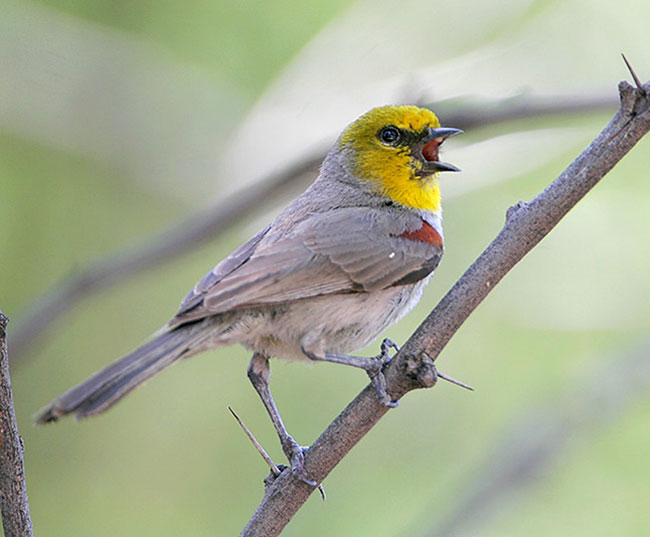Spot Energetic Verdin Birds in Southwest

In the vast and diverse landscapes of the American Southwest, a small yet lively inhabitant captures the attention of keen birdwatchers — the Verdin bird. This energetic species, resembling a tiny gray gem, can be found in brush habitats stretching from southern Utah and southwestern Oklahoma down to central Mexico. Despite its common occurrence and bustling activity, the Verdin’s diminutive size and camouflage can make it a delightful challenge to spot.
The Verdin’s appearance, characterized by its overall cryptic coloration, offers a subtle yet rewarding visual treat for those fortunate enough to witness it in action. Jennie Duberstein, the coordinator for the Sonoran Joint Venture, describes the pleasure of observing this bird as it hops about among the branches, occasionally revealing flashes of yellow on its head or rust hues on its shoulder. Historically associated with chickadees, recent research has revealed that the Verdin’s closest relatives are certain small songbirds found in Europe, Asia, and Africa, as noted by birding experts Kenn and Kimberly Kaufman.

To catch a glimpse of the Verdin in its natural habitat, head to Saguaro National Park near Tucson, Arizona, where you can witness its vibrant energy firsthand.
A significant portion of the Verdin’s diet consists of insects. To attract these spirited birds, Jennie recommends creating an environment that provides the necessary structures and food sources. In her own yard, mesquite and paloverde trees are favored by Verdins, along with cacti like chollas. These dynamic fliers are also known to visit hummingbird feeders for sugar water and nectar plants, making a garden adorned with native flowering plants an ideal spot to draw them in. Remarkably agile, Verdins are even skilled at feeding while hanging upside down.

Verdins showcase their architectural prowess through their nest construction, which they engage in throughout the year. These avian artisans create remarkable round homes that serve as nesting sites as well as roosts. Featuring a diameter of about 6 inches and an entrance typically placed toward the bottom, these thorny globes offer exceptional protection against predators and the region’s extreme temperatures. The domed design ensures cooler interiors during the summer and warmer shelter during the winter months. Male Verdins play an essential role in nest building, mainly responsible for setting up the thorny outer structure. Females take charge of interior decorating, adding a soft lining composed of grass and plant fibers.
For those aspiring to attract Verdins to their backyards, planting native shrubs is a fantastic way to provide suitable nesting and roosting sites, while also offering shade during the scorching summers.

As part of the intricate life cycle of the Verdin, the juvenile members of the species possess a distinct appearance. Sporting an all-gray plumage and a vibrant yellow beak that matures over time, these young birds exhibit their own unique beauty. Caroline Horowitz of Chandler, Arizona, captured the essence of a juvenile Verdin during an early morning walk, expressing her joy at the opportunity to observe and appreciate its fleeting elegance.
In the heart of the Southwest’s rugged landscapes, the Verdin bird thrives as a testament to nature’s ability to adapt and flourish. Its vibrant energy and resilient spirit serve as an inspiration, reminding us of the wonders that await those who venture into the wild.



